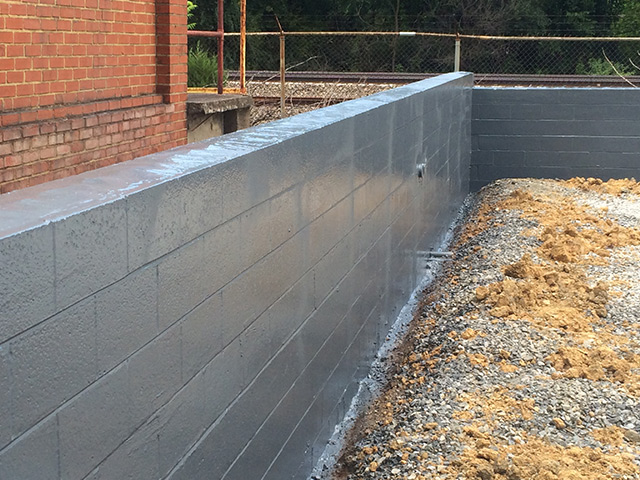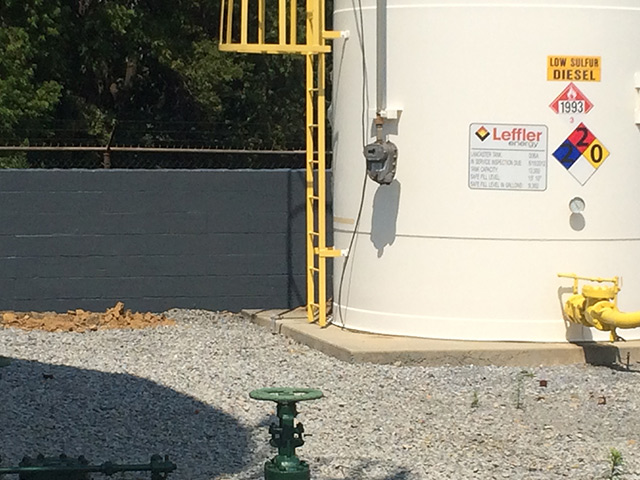Concrete and polyurea seem to go hand in hand in the secondary containment world. This winning duo was no different at the Leffler Energy jobsite in Lancaster, Pa., when the containment that was supposed to be protecting the ground from accidental oil spills started showing signs of aging.
The client wanted to be proactive in
maintaining the system, so they called in some experts to get an upgrade. “They’re
a proactive company,” explained Richard Franklin of Oak Ridge Foam and
Coatings, the coatings manufacturer on this project. “They’re not waiting for a
problem; they’re ahead.” Therefore, Leffler Energy’s environmental person
reached out to EnviroTite Services, LLC out of Hackettstown, N.J.,
to help them come up with an upgrade strategy that would meet the Spill
Prevention, Control, and Countermeasure (SPCC) requirements of the U.S. Environmental
Protection Agency (EPA).
Ready to Go
This
was a quick and efficient project. It took a three-person crew from EnviroTite
Services and three weekdays to complete the 3,500-square-foot (325.2 m²)
recoat. Three was certainly a good number on this project!
The first step was to have the client prepare
the site. EnviroTite Services Owner Dominick Desiderio asked Leffler to remove
the old gravel from the bottom of the containment, dig down into the clay about
six inches (15.2 cm) around the perimeter walls, and then let the coatings crew
do its thing. “I told the owner to dig at the base of the wall…so that we could
get our coating down below the clay liner on the floor,” Desiderio explained. With
the area prepped, the crew then needed to get in and get the substrate ready.
The concrete block walls were in fair
condition, but the existing coating that was on them was starting to peel and
flake off. “Moisture was getting into
the walls through the top, which resulted in existing coating failure,” said
Desiderio. If the containment wasn’t recoated, Leffler would be in danger of
having some structural damage done to the walls.

This meant that the first day, the
EnviroTite Services crew needed to remove all loose and flaking paint. They power washed the concrete containment using a rotary nozzle. While
letting the concrete dry, they covered up the pipes and pumps with plastic
sheets to protect them from overspray later in the process.
“That actually brought us in through the
weekend, so we returned the following week to make repairs,” Desiderio
explained. On Monday, they used hydraulic cement to patch any of the blown out
or cracked parts of the concrete and to seal any pinholes. Finally, the crew
was ready to get to the good stuff: the coatings!
Complete Containment
Wielding
a Graco 690 sprayer with a #619 tip, the EnviroTite Services crew applied the
primer at approximately 2–3 mils (50.8–76.2 microns). The OR811 primer from Oak Ridge is a
single-component coating. After that, the crew applied the polyurea, which was
OR80WPM (also from Oak Ridge).
Wearing hard hats, 3M safety glasses and respirators, gloves, and protective
clothing, the crew applied the polyurea at approximately 50–60 mils
(1,270–1,524 microns) in two passes. And because the polyurea is a
plural-component, 100 percent solids, zero volatile organic compound (VOC)
material, they used a Graco Fusion CS gun to apply it up and over the walls.
There,
they created a termination edge about eight inches (20.3 cm) from the top of
the concrete wall. This containment was going to keep things where they
belonged.
One of the greatest advantages of using a
polyurea coating is that it cures almost instantly. For an oil company, getting
the equipment back on the line as quickly as possible is one of the most — if
not the most — important aspects of
choosing a solution. Because polyurea cures so quickly, it reduces downtime, as
Franklin explained, something that was necessary to the client.
This
project worked so quickly, in fact, that the crew finished spraying around 9 or
10 a.m. and the client was back in there within an hour of the polyurea
application to start backfilling the walls with clay and gravel.
Staying Ahead
The people at Leffler Energy sought out a solution, made it happen, and made it right. It took the right coatings crew, the right coatings, and the right setup to get everything up to date. The only unscheduled item of note was when Desiderio needed to talk to the electrician about moving some pipes on one wall. “He had to come out, disconnect it, and relocate a few pipes so we could get the coating behind the pipes properly,” Desiderio said. Everything else went as seamlessly as the system, and even working with the electrician wasn’t difficult. Franklin was also impressed with the client, including that he was pleased with the final setup. “We’ve been at oil tank fields that don’t even have a clay liner in them,” said Franklin. Now Leffler Energy has so much more than that bare minimum: They have a recoated secondary containment with one sizzling upgrade!
